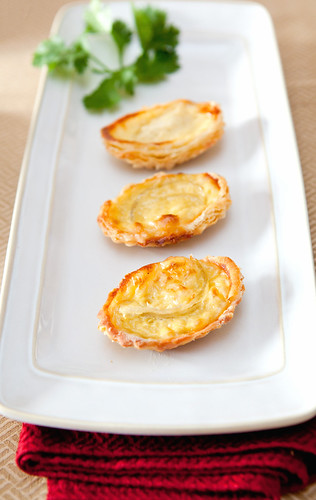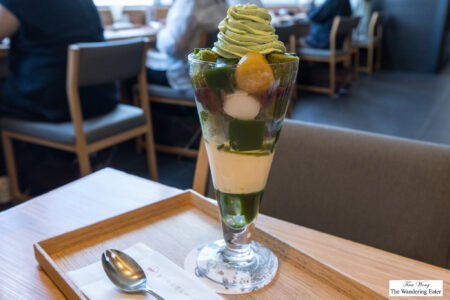This month, Foodbuzz has selected me to be one of their publishers to write their monthly 24×24 project. My proposal was to cook a Chinese New Year meal feast all from scratch. From the crispy roast pork (phonetically pronounced siew yuk; 烧肉) to egg custard tarts (dan tats (蛋撻), which I wrote last year (CLICK HERE for the recipe) with several other traditional dishes which I will talk about later. Chinese New Year (it’s the Year of the Rabbit) is starting on February 3, 2011. Granted, I’ve cooked this feast early but my brother has to be out of town the evening of Chinese New Year Eve (the most important day of this holiday) for work so it’s my excuse to celebrate early.
I know this sound relatively insane to cook and bake traditional Chinese dishes for Chinese New Year but it’s not that bad. Really! It’s just the veil of secrecy and lies that some Chinese restaurant owners and cooks that make those dishes look daunting to make. But if you know the basics of cooking, have a pantry that’s filled with some staple Asian ingredients, and a bit of audacity to do it you can make a few, if not all, of these dishes.
I invited six of my family and friends to join me for this meal. They were eager guinea pigs to try my dishes (since I was trying a few new recipes beyond my usual repertoire) and my parents were willing to assist me on cooking this feast (especially on the soups and meats). Toward the end of this post, are the recipes to the Crispy Roast Pork; you may jump to the recipe here) and Crystal Skinned Shrimp Dumpling (Har Gau; 蝦餃; for the recipe, click here).

 Homemade Bird Nest Egg Custard Tart or Dan Tat (燕窩蛋撻) & Homemade taro cake (芋頭糕)
Homemade Bird Nest Egg Custard Tart or Dan Tat (燕窩蛋撻) & Homemade taro cake (芋頭糕)
Here’s my family style menu (English name/description on top, bottom is transliteration and/or the Chinese name) after the jump:
Cocktail
Appetizers
Crystal Skinned Shrimp Dumpling
Har Gau (蝦餃)
Taro Cake (both steamed and pan fried)
Wu tao Go (芋頭糕)
Soups
Prosperity soup
Fat choy (a type of black moss or algae), dried oyster, dried shiitake, and dried scallops soup (chicken-based soup)
(髮菜干貝蠔豉東菇湯)

Pig’s Feet with Ginger in Black Vinegar (with hard boiled eggs)
(猪脚姜)
Main Courses
Crispy Roasted Pork
Siew Yuk (烧肉)
Salt Baked Chicken
(鹽焗雞)
Stir-fried rice with fresh shrimp, dried scallops, crispy roasted pork, and eggs
(炒瑤柱,蝦,烧肉飯)
Desserts
Egg Custard Tarts (regular, matcha green tea and bird’s nest (pronounced yian wo; 燕窝; latter referring to the stuff found in Bird Nest Soup)
Dan tat (蛋撻)
Red bean and coconut jelly
Yezi Hong dou Gao (椰子紅豆糕)
Yes, it’s a lot of food but that is the point for Chinese New Year. Ideally, the household should cook enough food to last the entire 15-day holiday, from the evening of Chinese New Year Eve to the 15th day after.



The whole shebang (top left); Homemade Chinese roast pork belly (烧肉; top right), Prosperity Soup: Fat choy, dried oyster, dried scallop, dried shitake mushroom soup (髮菜牡蠣干貝东菇湯);
To explain the some of the symbolism behind the meal, shrimp in Chinese (in Cantonese) is pronounced ha, which means happiness (since it sounds like someone who is laughing). Oysters means good (whether it be fortune, well being, news, etc.). Whole chicken is by default, traditional to eat. As for the Pig’s Feet in ginger and black vinegar, the pig feet (as in the Cantonese dialect, we’re referring to the “hands” rather than its rear legs) would grab all the money and fortune. The bird’s nest in my egg tarts is really meant to show off to my relatives and friends since it’s $3,000 – $6,000 US per pound, depending upon the grade, quality, and color of the nest.
Here’s the recipe (more like a guide) to make Crispy Roast Pork. I used the pork belly portion since it has the skin on even though it treads to excess subcutaneous fat in proportion to meat but it’s still very delicious.
Siew Yuk (烧肉) (Printable recipe in PDF here)
Ingredients:
5 pounds of pork belly (with skin on)
Wet marinade (for the meat/muscle side of the belly):
2 ounces fermented bean sauce
2 ounces hoisin sauce
1 teaspoon five-spice powder
4 teaspoon salt
1 tablespoon MSG (optional but it’s traditional)
1 tablespoon black pepper
Dry marinade (for the skin):
1 tablespoon salt
1 teaspoon five-spice powder
Approximately 1.5 to 2 fluid ounces of Vodka (the better quality, it results to a better tasting product; I used Purity Vodka)
Instructions:
1. Mix the wet marinade ingredients in a medium sized bowl. In a separate bowl, mix the dry marinade ingredients except for the vodka.
2. Rinse and pat dry your pork belly. Prick as many holes as you can with your Jaccard or a sharp knife. This would cause the skin to blister in the hot oven and allow steam to evaporate to create that lovely, crispy texture.
3. Set your pork on a clean wire rack that has a sheet pan underneath. Boil water with a kettle (or saucepan) and pour the hot water on the skin only. Your aim is not to poach your pork in hot water, just scald the skin. This makes the skin tighter and promotes dryness. Pat the pork meat and skin dry.
4. Flip skin side down. Slather the wet marinade, as evenly as possible, on the muscle/meat portion of the pork belly.
5. Flip the belly so it’s skin side up. Brush or rub the vodka onto the pig skin. Add the salt and spice mixture on the skin and press it on, so it would stick.
6. Let this sit in a cool room or refrigerator, at least overnight. About 2-3 hours prior to roasting, it would be suggested to dry the pork even further with a fan turned on.
7. Preheat the oven to 425 degrees Fahrenheit. Set the marinated pork on a roasting or broiler pan set up with a rack so it will not touch the surface of the pan, with the skin side up. Oven for approximately 45 minutes or until it is cooked.
8. If the pork is completely cooked but the skin is not crisp and blistering, turn on your broiler and watch it from burning. Once you’ve acquired that gorgeous, bumpy, golden to dark brown skin, let it sit to cool for at least 30 minutes. Chop into fairly large chunks with a cleaver or heavy chef’s knife (you need the extra weight to cut through the crisp skin and the occasional rib bone). Serve immediately and savor.

Fresh, crackly, porky goodness fresh out of the oven
Recipe:
Har Gau (蝦餃) (Printable recipe in PDF here)
Ingredients
For the skin/wrapper
1½ cups of wheat starch, plus extra for kneading (if needed); this is usually found in Asian grocery stores
2 tablespoon of tapioca starch; this is usually found in Asian grocery stores
1 cup of boiling water
A pinch of salt
1 teaspoon of lard or oil, optional
For the filling
1 pound of peeled and deveined shrimp
2 tablespoons of minced bamboo shoots or water chestnuts
1 teaspoons of minced scallion (white part only, optional)
1 teaspoons of finely grated ginger
3 teaspoons of soy sauce
2 tablespoons of Shaoxing wine or dry sherry
½ teaspoon of salt
2 teaspoons sesame oil
4 teaspoons tapioca starch, potato starch, or corn starch
A dash of white pepper
Instructions:
1. Mince or coarsely chop the shrimp. (I did the latter because I wanted to show the quality and large size of the shrimp I bought.) Mix all of the ingredients for the filling. Set aside.
2. In a large mixing bowl, mix the dry ingredients of the skin together. Create a well and pour in the boiling water. Mix with a wooden spoon until it forms a cohesive dough. You may knead with your hands once the temperature is tangible enough for you to handle. If the dough it too tacky, add more wheat starch but generally this dough should feel like Play-Doh, if you ever touched those children’s modeling compound before.
3. Divide the dough into 3 long cylinders or logs and cut into 1-inch pieces. Keep the dough under a moist kitchen towel or in a plastic zip-top bag.
4. Take a piece, press down on it so it becomes a somewhat flat circle and roll out until it’s about 1/8-inch thick. You need it to be this thin (or thinner, if you’re an expert pleater) so by the time it finishes steaming, it will be translucent.
5. Take the rolled-out dough and add ½ to 1 teaspoonful of filling to the center. Curl your hand (the one that’s holding the dumpling) up to the point that it looks like you’re folding it in half. Choose one side and pinch the end. Pleat and gather, at the same time, to one side until you get the bonnet-like shape of the dough.*
You may see this YouTube video (the link here, if it doesn’t work) below to see the general idea as to how to proceed to make the skin:
6. Place the wrapped dumpling into a steamer lined with blanched napa cabbage (to prevent sticking and the blanching part is to let the cabbage lay down flat). Repeat steps 4 and 5 until you’ve used up all your dough and/or filling.
7. Steam your dumplings, if the water is at a rolling boil, for 5-6 minutes. Do not overcook since shrimp is very easy to overcook and it would result in a gritty, overly chewy dumpling.
8. Plate and serve immediately with a side of soy sauce, if you prefer.
*At this step, you may freeze the uncooked, wrapped dumplings. Just line a baking sheet with parchment, wax paper or simply flour it, and set your dumplings with a little bit of space to prevent sticking to each other. Once you’re done wrapping, freeze it until it is rock hard. Remove the frozen dumplings from the baking sheet and place them into a freezer storage bag.
If you do cook these frozen dumplings, do keep in mind you need to add an extra 2-3 minutes since they are frozen. You do not need to defrost the dumplings prior to steaming them.

Homemade Har Gow or Crystal Skin Shrimp Dumplings (蝦餃)
Gong hai fat choy! 恭喜發財! Happy New Year! 新年快樂!
For more photos of my Chinese New Year feast, please scroll through the slideshow below:
[tylr-slidr userID=”hellokitty893112″ groupID=””]http://www.flickr.com/photos/hellokitty893112/sets/72157625930208088/[/tylr-slidr]






Pingback:Tweets that mention Foodbuzz 24×24: (Early) Chinese New Year Feast « The Wandering Eater -- Topsy.com
Looks great! This makes me miss home.
Thanks! Home cooked food is always better and memorable. :)
Happy New Year your started off on the right foot this looks great Congrat!
All of this looks delicious, and your photos are absolutely gorgeous! Congrats on being chosen for 24×24!
Courtney Thank you for the compliments! :D
What an impressive spread! You were lucky to have family members around to help you make all of the special dishes–and, of course, to help you eat them,
Emiglia Thanks! It helps to have extra people helping making the food, eating it, and sharing the happiness.
Looks great! I’d like to try the Har Gau. Any way to get the recipe printable?
Chuck Thank you!
I posted printable versions of both featured recipes in PDF format. Hope it works or email me so I can send it to you, if the link does not work.
Wow. Looks delicious. And your table setting looks beautiful. Happy New Year (belated)!
Adam: Thank you! Happy new year to you, too! :)